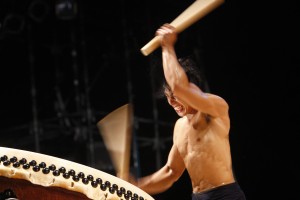Ask an Artist: Jun Akimoto, Kodo member
The traditional Japanese drumming ensemble Kodo was last in Ann Arbor in 2008. The group was a hands-down hit with audiences of all ages. Kodo returns to Hill Auditorium next Wednesday, February 23 with songs from their January 2011 release, Akatsuki. When we asked Kodo member Jun Akimoto if he would be game for responding to fan questions prior to the performance via umsLobby.org, he was more than happy to connect directly with UMS audiences. Read on for his outstanding responses to fan questions, submitted from Kodo enthusiasts via email and the UMS Facebook page.
Fan #1, Diane Antczak
Q. How did Kodo start?
A. Kodo started in 1971 with the idea of a college on Japan’s Sado Island that teaches younger people Japanese traditional craftsmanship and culture. The drumming was one of the means to earn money to realize this dream. In present day, the drumming has become main stream of the activities of this group.
Q. Who orchestrates the moves and music?
A. Normally we work together, even when an artistic director was chosen from the Kodo performers. When a director is from outside Kodo, he or she often has more individual leadership.
Q. Is Kodo popular in Japan?
A. It is not as popular as pop musicians or entertainers, but quite known as a Japanese drumming group.
Q. How are potential performers selected?
A. We have a two-year apprenticeship and anyone who wants to become a regular performer of Kodo is required to accomplish the program and pass several auditions.
Q. Do Kodo members have groupies?
A. No, unfortunately (fortunately?).
Q. Are there age restrictions – is retirement encouraged at a certain age?
A. There has been no retirement age yet, even though the oldest performers are now 60. We look forward to seeing them how far they can go. Apprentices need to be 18 and above to apply to the apprentice center.
Q. Do players rotate performances?
A. In many cases, yes. But some styles have limited accessibility such as “O-daiko (biggest drum) or certain type of dances and songs.
Q. How many players belong to the group?
A. We now have about 25 performers.
Fan #2, Mary Orr
Q. I would love to know more about what communal life on Sado Island is like. Is it like living in an ashram or a monastery?
A. We do not know anything about an ashram or a monastery, so it’s very difficult to give you a right answer. But it should be different because Kodo is not a religious organization, but a commercial musical/performing arts group and our lives on Sado Island is a cradle of creation which will be our main resources of imagination vital for Kodo’s performing arts. Our communal life is very important to maintain a good relationship amongst the Kodo members, not only in daily life but also in performing ensemble on stage.
Fan #3, Lisa Bee
Q. Are the drummers in your group solely professional taiko drummers or do they have a separate profession in addition to their drumming?
A. Kodo is a professional group and all the performers and staff make a living with 100% commercial income from performances and other related activities.
Fan #4, Keisuke Tanabe (4-years old)
Q. Hi my name is Keisuke. I saw you guys on YouTube and I think you’re SO COOL! I have a question. Is the BIG drum bigger than me? I’m 3ft 4in(102cm) tall.
A. The big drums are about 120 cm in diameter at the edge of the body, but the body is a round-shape so the center area should be much bigger.
Fan #5, Jackie Beauchamp
Q. How many hours of practice a week does it take to get good at what you do? Then how much work is it to maintain that level of performance?
A. Normally while we are not touring, the performers practice together from 9 till 18:00 everyday except Sunday. After 18:00 till 22:00 is time for individual practice. When we are on the road, they practice, rehearse and perform all day on the days of performances.
Fan #6, Chris Voge
Q. Do you make your own drums?
A. No, we have used drums manufactured by Asano Taiko for nearly 40 years.; they are one of the leading taiko makers in Japan. They have 400-year history and their drums are in highest quality in terms of exquisite art of work, great durability and sound design, best materials. This is traditional and professional craftsmanship and we are unable to learn or develop.
Fan # 8, Annemarie Schoennemann
Q. Has anyone been injured playing with Kodo? If so, what was the nature of the injury? What kind of physical training is required of members to avoid injuries?
A. Small accidents happens quite often such as hitting their faces with sticks, bleeding from blisters on their hands, etc., but major injury is rare nowadays. In the past, some performers hurt their backs and not much since we have developed more practical physical treatment, such as warm-up / cool-down appropriately, stretching, icing, etc.
Fan # 9, Archer Horner (7-years old)
Q. How do you listen to the beat?
A. They not only listen, but also feel the beat of each other. Beat is the means of communication and they always try to find a right spot and sequence or groove in order to keep the beat right. This is a collective teamwork, so they try to feel what the others say, then feel and understand in order to work together to produce the beat together.


